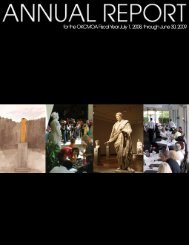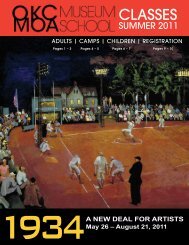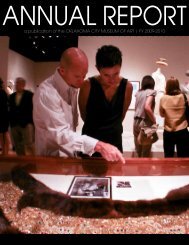Roman Art from the Louvre Educators' Resource Guide
Roman Art from the Louvre Educators' Resource Guide
Roman Art from the Louvre Educators' Resource Guide
You also want an ePaper? Increase the reach of your titles
YUMPU automatically turns print PDFs into web optimized ePapers that Google loves.
18<br />
Intere sting Facts about Ancient Rome<br />
Women in ancient Rome dyed <strong>the</strong>ir hair with goat fat and beech wood<br />
ashes. Red and blond were <strong>the</strong> most popular colors.<br />
Trajan’s Column is 128 feet high, which is <strong>the</strong> same height as a nine-story<br />
building. The sculptural frieze that wraps around <strong>the</strong> column is approximately<br />
655 feet in length—<strong>the</strong> length of about two football fields—and<br />
depicts more than 2,500 men.<br />
The Circus Maximus, a <strong>the</strong>ater in Rome, could hold as many as 250,000<br />
spectators. New York’s Yankee Stadium holds approximately 60,000 people.<br />
Instead of soap, <strong>Roman</strong>s used oil, which <strong>the</strong>y rubbed into <strong>the</strong>ir skin and<br />
<strong>the</strong>n scraped off with a metal tool called a strigil.<br />
When <strong>the</strong> <strong>Roman</strong> Empire reached its territorial peak in 116 A.D., it spanned<br />
2.5 million square miles.<br />
Lead was used as both a preservative and a sweetening agent.<br />
The toga, <strong>the</strong> official costume of <strong>the</strong> <strong>Roman</strong> citizen, was created using a<br />
semi-circular piece of white wool cloth that was about 18H feet in diameter.<br />
Many gladiators, like athletes today, chose colorful surnames to enhance <strong>the</strong>ir<br />
public identity. One gladiator, whose name is preserved on a funerary monument,<br />
was known as Antaios, <strong>the</strong> name of a giant <strong>from</strong> Greek mythology.<br />
The trepan, or drill, that ancient sculptors used to create <strong>the</strong>ir art was also<br />
used as a surgical instrument to bore holes into <strong>the</strong> skull. This procedure<br />
(called trepanning) was thought to cure headaches, treat brain disorders,<br />
let out evil spirits, and treat insanity.<br />
<strong>Roman</strong> charioteers belonged to racing clubs or teams. The most well known<br />
were <strong>the</strong> Whites, Blues, Greens, and Reds.<br />
<strong>Roman</strong> bath houses used an advanced heating system called hypocaust to<br />
heat <strong>the</strong> caldarium (hot bath) and tepidarium (lukewarm bath), as well as<br />
<strong>the</strong> floors and walls of <strong>the</strong> complex.<br />
<strong>Roman</strong>s played board games such as chess, checkers, and tic-tac-toe.<br />
Many ancient <strong>Roman</strong> houses had flushing toilets and indoor plumbing.<br />
Associated with Mercury, <strong>the</strong> messenger god, a caduceus (a winged stick<br />
encircled by two snakes) came to be linked with postal workers and<br />
journalists. The caduceus of Mercury is often confused with <strong>the</strong> rod of<br />
Asclepius —a staff with a single serpent—which is a symbol of medicine.
















